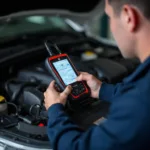Connecting your OBD2 scanner can seem daunting, but with a little guidance, it’s a simple process that unlocks a wealth of information about your vehicle’s health and performance. This guide provides everything you need to know about connecting your OBD2 scanner, from locating the port to troubleshooting common issues.
Locating Your OBD2 Port
Most vehicles manufactured after 1996 have an OBD2 port. It’s typically located under the dashboard on the driver’s side, often near the steering column or beneath the glove compartment. Sometimes, it can be hidden behind a panel or tucked away near the center console.
If you’re having trouble finding the port, consult your vehicle’s owner’s manual. It should contain a diagram showing the exact location of the OBD2 port in your specific make and model.
Connecting Your OBD2 Scanner
Once you’ve located the OBD2 port, connecting the scanner is straightforward. Simply plug the scanner’s connector into the port. It should fit snugly and securely. Most OBD2 scanners are plug-and-play, meaning no additional setup is required.
For Bluetooth OBD2 scanners, you’ll need to pair the device with your smartphone, tablet, or computer. This usually involves turning on your device’s Bluetooth, searching for available devices, and selecting your OBD2 scanner from the list. See how to connect obd2 bluetooth to pc.
Troubleshooting Connection Issues
Occasionally, you might encounter problems connecting your OBD2 scanner. Here are some common issues and solutions:
- Loose Connection: Ensure the scanner is firmly plugged into the port. A loose connection can prevent communication.
- Incompatible Scanner: Make sure your OBD2 scanner is compatible with your vehicle’s make, model, and year.
- Blown Fuse: Check the OBD2 fuse in your vehicle’s fuse box. A blown fuse can disrupt power to the port. Check this article on 2013 transit connect obd2 fuse location.
- Software Issues: If you’re using a Bluetooth OBD2 scanner, ensure your device’s Bluetooth is enabled and that the scanner’s software is up-to-date.
“A common oversight is forgetting to check the OBD2 fuse,” says automotive diagnostician Michael Stevens. “It’s a simple fix that can save you a lot of frustration.”
Different Connection Methods
There are several ways to connect obd2 scanners, each with its own advantages. Bluetooth connections are popular for their wireless convenience. Wired connections offer a more stable and reliable connection, particularly for data-intensive applications. Wi-Fi OBD2 adapters create their own wireless network, which can be helpful for connecting multiple devices. Learn more about connecting to your Android head unit by reading how to connect obd2 to android head unit.
Why Connect OBD2?
Connecting your OBD2 scanner opens up a world of possibilities for understanding and managing your vehicle’s performance. From diagnosing check engine lights to monitoring fuel economy, an OBD2 scanner is a powerful tool for any car owner. See how to connect obd2 to android. You can even use it to track your driving habits and identify areas for improvement. For older vehicles, understanding how to how to safely connect obd2 civic 2006 is important.
“An OBD2 scanner is like having a mechanic in your pocket,” says automotive engineer Sarah Chen. “It empowers you to take control of your car’s maintenance and make informed decisions about repairs.”
Conclusion
Connecting your OBD2 scanner is a simple yet crucial step towards understanding your vehicle’s health. By following these guidelines and troubleshooting tips, you can easily connect obd2 and unlock valuable insights into your car’s performance.
FAQ
- What does OBD2 stand for? OBD2 stands for On-Board Diagnostics, Second Generation.
- Where can I find my OBD2 port? The OBD2 port is typically located under the dashboard on the driver’s side.
- What if my car doesn’t have an OBD2 port? Cars manufactured before 1996 may not have an OBD2 port.
- Why is my OBD2 scanner not connecting? Check for loose connections, blown fuses, or compatibility issues.
- What can I do with an OBD2 scanner? Diagnose check engine lights, monitor fuel economy, track driving habits, and more.
- Do I need a special app to use a Bluetooth OBD2 scanner? Yes, you’ll need a compatible app on your smartphone, tablet, or computer.
- Can I use an OBD2 scanner on multiple vehicles? Yes, most OBD2 scanners are compatible with a wide range of vehicles.
Common OBD2 Connection Scenarios
- Scenario 1: Difficulty locating the OBD2 port in an older vehicle. Solution: Consult the owner’s manual for the exact location.
- Scenario 2: Bluetooth OBD2 scanner not pairing with a smartphone. Solution: Check Bluetooth settings on both devices and ensure the scanner’s software is updated.
- Scenario 3: OBD2 scanner showing error codes. Solution: Use a reliable OBD2 code reader app or consult a mechanic to interpret the codes.
Further Reading and Resources
- Explore our other articles on OBD2 scanners and car diagnostics on our website.
- Check out online forums and communities for discussions and troubleshooting tips.
Need further assistance? Contact us via WhatsApp: +1(641)206-8880, Email: [email protected] or visit us at 789 Elm Street, San Francisco, CA 94102, USA. We offer 24/7 customer support.


